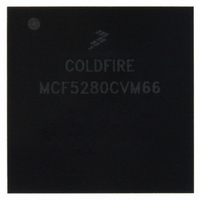MCF5280CVM66 Freescale Semiconductor, MCF5280CVM66 Datasheet - Page 266

MCF5280CVM66
Manufacturer Part Number
MCF5280CVM66
Description
IC MPU 32BIT COLDF 256-MAPBGA
Manufacturer
Freescale Semiconductor
Series
MCF528xr
Datasheet
1.MCF5216CVM66J.pdf
(766 pages)
Specifications of MCF5280CVM66
Core Processor
Coldfire V2
Core Size
32-Bit
Speed
66MHz
Connectivity
CAN, EBI/EMI, Ethernet, I²C, SPI, UART/USART
Peripherals
DMA, LVD, POR, PWM, WDT
Number Of I /o
142
Program Memory Type
ROMless
Ram Size
64K x 8
Voltage - Supply (vcc/vdd)
2.7 V ~ 3.6 V
Data Converters
A/D 8x10b
Oscillator Type
External
Operating Temperature
-40°C ~ 85°C
Package / Case
256-MAPBGA
Controller Family/series
ColdFire
No. Of I/o's
150
Program Memory Size
2KB
Ram Memory Size
64KB
Cpu Speed
66.67MHz
Embedded Interface Type
CAN, I2C, SPI, UART
No. Of Pwm Channels
8
Rohs Compliant
Yes
Lead Free Status / RoHS Status
Lead free / RoHS Compliant
Eeprom Size
-
Program Memory Size
-
Available stocks
Company
Part Number
Manufacturer
Quantity
Price
Company:
Part Number:
MCF5280CVM66
Manufacturer:
FREESCAL
Quantity:
151
Company:
Part Number:
MCF5280CVM66
Manufacturer:
Freescale Semiconductor
Quantity:
10 000
Company:
Part Number:
MCF5280CVM66J
Manufacturer:
Freescale Semiconductor
Quantity:
10 000
Company:
Part Number:
MCF5280CVM66L
Manufacturer:
FREESCAL
Quantity:
151
- Current page: 266 of 766
- Download datasheet (9Mb)
Signal Descriptions
2
14.2.9
I
C Signals
2
The I
C module acts as a two-wire, bidirectional serial interface between the processor and peripherals
2
with an I
C interface (such as LCD controller, A-to-D converter, or D-to-A converter). Devices connected
2
to the I
C must have open-drain or open-collector outputs.
14.2.9.1 Serial Clock (SCL)
2
2
This bidirectional open-drain signal is the clock signal for the I
C interface. Either it is driven by the I
C
2
module when the bus is in the master mode or it becomes the clock input when the I
C is in the slave mode.
This pin can also be configured as GPIO PAS0 or UTXD2.
14.2.9.2 Serial Data (SDA)
2
This bidirectional open-drain signal is the data input/output for the I
C interface.
This pin can also be configured as GPIO PAS1 or URXD2.
14.2.10 UART Module Signals
The signals in the following sections are used to transfer serial data between three UART modules and
external peripherals.
14.2.10.1 Transmit Serial Data Output (UTXD[2:0])
UTXD[2:0] are the transmitter serial data outputs for the UART modules. The output is held high (mark
condition) when the transmitter is disabled, idle, or in the local loopback mode. Data is shifted out, lsb
first, on this pin at the falling edge of the serial clock source.
The UTXD[1:0] pins can be configured as GPIO ports PUA2 and PUA0. The UTXD2 output is offered on
3 pins and is a secondary function of the EMDC/ GPIO port PAS4 pin, CANTX/GPIO port PAS2 pin, and
SCL/GPIO port PAS0 pin.
14.2.10.2 Receive Serial Data Input (URXD[2:0])
URXD[2:0] are the receiver serial data inputs for the UART modules. Data received on these pins is
sampled on the rising edge of the serial clock source lsb first. When the UART clock is stopped for
power-down mode, any transition on this pin restarts it.
The URXD[1:0] pins can be configured as GPIO ports PUA3 and PUA1. The URXD2 input is offered on
3 pins and is a secondary function of the EMDIO/GPIO port PAS5 pin, CANRX/GPIO port PAS3 pin, and
SDA/GPIO port PAS1 pin.
14.2.10.3 Clear-to-Send (UCTS[1:0])
The UCTS[1:0] signals are the clear-to-send (CTS) inputs, indicating to the UART modules that they can
begin data transmission.
The UCTS[1:0] inputs are each offered as secondary functions on four pins--DTIN2, DTOUT2, DTIN0
and DTOUT0.
MCF5282 and MCF5216 ColdFire Microcontroller User’s Manual, Rev. 3
14-26
Freescale Semiconductor
Related parts for MCF5280CVM66
Image
Part Number
Description
Manufacturer
Datasheet
Request
R
Part Number:
Description:
Manufacturer:
Freescale Semiconductor, Inc
Datasheet:
Part Number:
Description:
Manufacturer:
Freescale Semiconductor, Inc
Datasheet:
Part Number:
Description:
Manufacturer:
Freescale Semiconductor, Inc
Datasheet:
Part Number:
Description:
Manufacturer:
Freescale Semiconductor, Inc
Datasheet:
Part Number:
Description:
Manufacturer:
Freescale Semiconductor, Inc
Datasheet:
Part Number:
Description:
Manufacturer:
Freescale Semiconductor, Inc
Datasheet:
Part Number:
Description:
Manufacturer:
Freescale Semiconductor, Inc
Datasheet:
Part Number:
Description:
Manufacturer:
Freescale Semiconductor, Inc
Datasheet:
Part Number:
Description:
Manufacturer:
Freescale Semiconductor, Inc
Datasheet:
Part Number:
Description:
Manufacturer:
Freescale Semiconductor, Inc
Datasheet:
Part Number:
Description:
Manufacturer:
Freescale Semiconductor, Inc
Datasheet:
Part Number:
Description:
Manufacturer:
Freescale Semiconductor, Inc
Datasheet:
Part Number:
Description:
Manufacturer:
Freescale Semiconductor, Inc
Datasheet:
Part Number:
Description:
Manufacturer:
Freescale Semiconductor, Inc
Datasheet:
Part Number:
Description:
Manufacturer:
Freescale Semiconductor, Inc
Datasheet:











